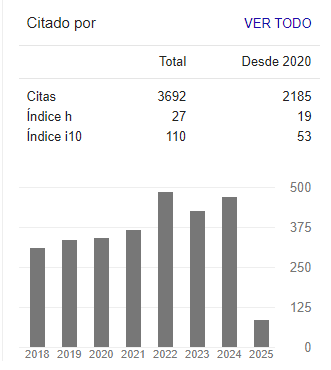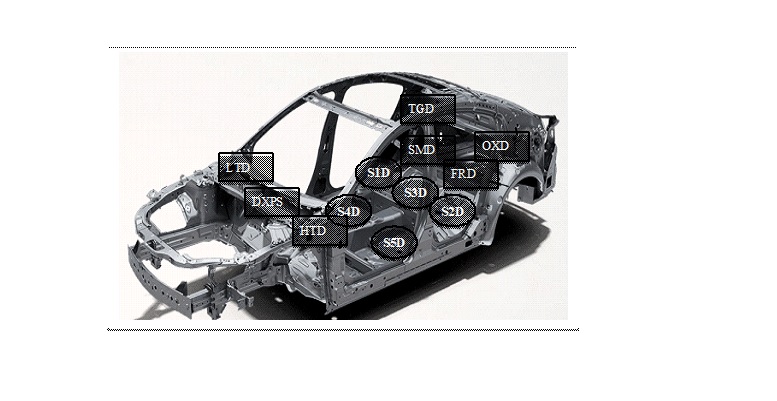
DOI:
https://doi.org/10.14483/23448393.18493Published:
2022-01-04Issue:
Vol. 26 No. 3 (2021): September - DecemberSection:
Sección Especial: Mejores artículos extendidos - WEA 2021Extraordinary Passive Safety in Cars Using a Sensor Network Model
Seguridad pasiva extraordinaria en automóviles usando un modelo de red de sensores
Keywords:
automobile, sensor network, active safety, passive safety, extraordinary passive safety (en).Keywords:
automóvil, red de sensores, seguridad activa, seguridad pasiva, seguridad pasiva extraordinaria (es).Downloads
References
H.-Y. Zhang, “The research about fire prevention of vehicle refueling station”, Procedia Engineering, no. 71, pp. 385-389, 2014. https://doi.org/10.1016/j.proeng.2014.04.055 DOI: https://doi.org/10.1016/j.proeng.2014.04.055
Honeywell, El libro del gas, North Carolina, USA: Honeywell, 2013. https://www.honeywellanalytics.com
T. Giebel, M. M. Meinecke, M. A. Obojsky, M. Gonter, and U. Widmann, “Current trends in vehicle active safety and driver assistance development,” In FISITA World Autom. Cong., Munich, Germany, 2008.
R. Sagar, “Making cars safer through technology innovation,” Texas Instruments, 2017. https://www.ti.com/lit/wp/sszy009a/sszy009a.pdf?ts=1637254963783&ref_url=https%253A%252F%252Fwww.google.com.mx%252F (accessed Apr. 2, 2020).
M. Schulze, G. Noecker, and K. Boehm, “PReVENT: A European program to improve active safety” in 5th Int. Conf. Intell. Trans. Sys. Telecom., Brest, France, Jun. 2005. https://www.prevent-ip.org/en/public_documents/publications/papers_presentations/prevent_to_improve_active_safety
P. Putham , P. Tahlya, and N. Lubbe, “Active and passive safety passenger car technologies: potentials to save lives in India,” in Int. Res. Counc. Biomech. Inj. (IRCOBI Asia), Lonavala, India, Apr. 2018.
P. Sabarinath, “Passive Safety System for Side Impact in Cars”, Shanlax Int. J. Arts Sci. Human., vol. 7, no. 4, pp. 115-120, 2020. https://doi.org/10.34293/sijash.v7i4.1623 DOI: https://doi.org/10.34293/sijash.v7i4.1623
M. Östling, P. P. Pisharam, H. Jeppsson, and N. Lubbe, “Future passive safety needs: Predicted injury patterns and possible countermeasures”, in 14th Int. Symp. Accomp. Ex. Soph. Car Safety Syst., Manheim, Germany, Nov. 2018.
S. Robert et al., “Design and implementation of a fire and control system with enhanced security and safety for automobiles using neuro-fuzzy logic,” in IEEE 7th Int. Conf. Adap. Sci. Tech. (ICAST), Accra, Ghana, Aug. 2018. https://doi.org/10.1109/ICASTECH.2018.8507143 DOI: https://doi.org/10.1109/ICASTECH.2018.8507143
H. Yong-Taek, K. Dong-Ho, and K. Sung-Pil, “An experimental study on the automobile engine room fire using the extinguishing agents” Fire. Sci. Eng., vol. 28, no. 4, pp. 1-7, Aug. 2014. http://dx.doi.org/10.7731/KIFSE.2014.28.4.001 DOI: https://doi.org/10.7731/KIFSE.2014.28.4.001
J. R. Kuykendall, S. R. Shaw, D. Paustenbach, K. Fehling, S. Kacew, and V. Kabay, “Chemicals presents in automobile traffic tunnels and the possible community health hazards: a review of the literature” Informa Healthcare. vol. 21, no. 9, pp. 747-792, Oct. 2009. https://doi.org/10.1080/08958370802524357 DOI: https://doi.org/10.1080/08958370802524357
Y. Q. Wang, F. Y. Xia, and X. M. Jiang, “Study on Safety measures against fire in single highway for subtended traffic” App. Mech. Mat., vols. 438-439, pp. 968-974, Oct. 2013. https://doi.org/10.4028/www.scientific.net/AMM.438-439.968 DOI: https://doi.org/10.4028/www.scientific.net/AMM.438-439.968
R. W. Byard and R. A. James, “Car window entrapment and accidental childhood asphyxia,” J. Paed. Child Health, vol. 37, no. 2, pp. 201-202, Dec. 2001. https://doi.org/10.1046/j.1440-1754.2001.00586.x DOI: https://doi.org/10.1046/j.1440-1754.2001.00586.x
C. McLaren, J. Null, and J. Quinn, “Heat stress from enclosed vehicles: moderate ambient temperatures cause significant temperature rise in enclosed vehicles”, Pediatrics, vol. 116, no. 1, pp. 109-112, 2005. https://doi.org/10.1542/peds.2004-2368 DOI: https://doi.org/10.1542/peds.2004-2368
Bosch, “Bosch commercial products specialized in fire detection and extinguishing,” Bosch, 2016. https://greatbustardsflight.blogspot.com/2016/02/sistema-de-deteccion-de-fuego-y.html
UFT, “Diseño automotriz”, UFT, n.d. https://dautomotrizuft.weebly.com/chasis.htm (accessed Jun. 17, 2020).
S. Vignesh, V. J. Prakash, K. Dharmaseelan, and K. K. Bharathi, “Automation on Fire Prevention in Automobile”, Int. J. Res. Eng. Sci. Manage., vol. 2, no. 5, pp. 191-193, May 2019. https://www.ijresm.com/Vol.2_2019/Vol2_Iss5_May19/IJRESM_V2_I5_44.pdf
J. Horak, I. Schmerold, K. Wimmer, and G. Schauberger, “Cabin air temperature of parked vehicles in summer conditions: life-threatening environment for children and pets calculated by a dynamic model”, Theo.r App. Climatouftl., no. 130, pp. 107-118, Jul. 2016. https://doi.org/10.1007/s00704-016-1861-3 DOI: https://doi.org/10.1007/s00704-016-1861-3
K. Rathi and J. Gupta, “Vehicular child trap alert system”, Int. J. Elec. Electr. Comp., vol. 4, no. 3 pp. 63-66, May-Jun. 2019. http://eecjournal.com/uploads/issue_files/1-EEC-MAY-2019-3-Vehicular.pdf
J. N. Booth III, G. G. David, J. Waterbor, and G. McGwin Jr., “Hyperthermia deaths among children in parked vehicles”, Forensic Sci. Med. Pathol., no. 6, pp. 99-105, Mar. 2010. https://doi.org/10.1007/s12024-010-9149-x DOI: https://doi.org/10.1007/s12024-010-9149-x
F. Maysoon, A. Aldahiri, H. Alkhatabi, H. Alonezi, L. Mulla, and S. Razzaq, “Sensor based hyperthermia alert car application”, Comm. App. Elec., vol. 5, nº 2, pp. 44-55, May 2016. https://doi.org/10.5120/cae2016652232 DOI: https://doi.org/10.5120/cae2016652232
How to Cite
APA
ACM
ACS
ABNT
Chicago
Harvard
IEEE
MLA
Turabian
Vancouver
Download Citation
Recibido: 15 de agosto de 2021; Revisión recibida: 27 de agosto de 2021; Aceptado: 15 de septiembre de 2021
Abstract
Context:
The automobile industry has included active and passive safety. Active safety incorporates elements to avoid crashes and collisions. Some elements are ABS brakes and stabilization bars, among others. On the other hand, passive safety avoids or minimizes damage to the occupants in the event of an accident. Some passive safety features include seat belts and front and curtain airbags for the driver and other occupants.
Method:
In this research work, we propose a new category called Extraordinary Passive Safety (XPS).A model of a sensor network was designed to inspect the conditions inside the car to detect fire, smoke,gases, and extreme temperatures. The sensors send data to a device (DXPS) capable of receiving and storing the data.
Results:
Each sensor collects data and sends it to the DXPS every period. The sensor sends 0s while there is no risk, and 1s when it detects a risk. When the DXPS receives a 1, the pattern is evaluated, and the risk is identified. Since there are several sensors, the reading pattern is a set of 0s (000000). When a pattern with one or more 1s (000100, 010101) is received, the DXPS can send an alert or activate a device.
Conclusions:
The proposed solution could save the lives of children left in the car or people trapped when the car catches fire. As future work, it is intended to define the devices to avoid or minimize damage to the occupants such as oxygen supply, gas extraction, regulating the temperature, among others.
Keywords:
automobile, sensor network, active safety, passive safety, extraordinary passive safety..Resumen
Contexto:
La industria de los automóviles ha incluido seguridad activa y pasiva. La seguridad activa incorpora elementos para evitar choques y colisiones. Algunos elementos son frenos ABS y barras de estabilización, entre otros. Por otro lado, la seguridad pasiva evita o minimiza daños a los ocupantes en caso de haber un accidente. Algunos elementos de seguridad pasiva son los cinturones de seguridad y bolsas de aire, así como de cortina para el conductor y otros ocupantes.
Método:
En este trabajo de investigación se propone una nueva categoría llamada seguridad pasiva extraordinaria (SPX). Se definió un modelo de una red de sensores para censar las condiciones del interior del automóvil para detectar fuego, humo, gases y temperaturas extremas. Los sensores envían datos a un dispositivo capaz de recibir y almacenar los datos.
Resultados:
Cada sensor obtiene datos y los envía al dispositivo cada periodo de tiempo. El sensor envía 0s mientras no exista riesgo; al detectar un riesgo envía un 1. Cuando el dispositivo recibe un 1,se evalúa el patrón y se determina el riesgo. Dado que hay varios sensores, el patrón de lectura es un conjunto de 0 (000000). Cuando se recibe un patrón con uno o más ceros (000100, 010101) se puede activar una alarma o activar un dispositivo.
Conclusiones:
La solución propuesta podría salvar vidas de niños dejados en el automóvil o personas atrapadas al incendiarse el automóvil. Como trabajo futuro se pretenden definir los dispositivos para evitar o minimizar los daños a los ocupantes como suministro de oxígeno, extracción de gases, regulación de la temperatura, ente otros.
Palabras clave:
automóvil, red de sensores, seguridad activa, seguridad pasiva, seguridad pasiva extraordinaria..Introduction
Automobiles
Human beings require safe places, such as their home, office, and car. We spend most of the day in these places. A person or family travel inside a car, or the driver and passengers in the case of a public transport car. There are cars of different sizes and shapes. In this research work, we focus on cars with up to five passengers
The car has a cabin with seating for five passengers, where the front seats are for the driver and co-pilot and the rear seats are for the other three passengers. Babies have special seats attached to a back seat, and all passengers must wear a seat belt.
However, there are additional risks while the car is traveling or parked. This paper calls them Extraordinary Risks (XR). In order to mitigate XR, an extraordinary security sensor network (XSSN)connected to a Device of Extraordinary Passive Safety (DXPS) is proposed.
The risks considered for the occupants of the car are fire, accumulation of gases, and extreme temperature. These risks can cause suffocation, burns, poisoning, dehydration, or hypothermia.
Active safety
Active Safety (AS) is a set of devices in the car with the purpose of preventing accidents such as collisions or rollovers. Devices have been implemented to avoid running over pedestrians or cyclists [1], [2]. Other devices are in charge of the speed census, the distance between vehicles, and communication between vehicles before reaching an intersection for the emission of danger messages[3]. Static and dynamic environments can be monitored by implementing dynamic sensors,cameras, infrared rays, and radars. Monitoring makes it possible to implement dynamic actuators,and census data can be concentrated in a sensor control center [1], [2]. The monitoring uses algorithms for object identification and corner and edge detection. These algorithms use the following techniques of: Classification, Support Vector Machine, K-Nearest Neighbors, and Convolutional Neural Networks (SVM, KNN, and CNN) [2].
Passive safety
Passive safety aims to minimize potential injuries to occupants. Airbags are placed to save lives and react after 30,000 milliseconds. Other accessories are seat belts and seats for babies. Occupants can be protected by passive safety by 84-96%[4]. Seat belts are individual and activate in 20,000 milliseconds to support the occupant. Even seat belts with a pneumatic system have been proposed for greater effectiveness. Accidents are severe or fatal up to 40% of the time[5]. 13% of collisions can happen from the front and 14% from the side. Crashes can cause injuries to the head, abdomen,and spine of the occupants[6].
Risks
Risk of fire
Systems have been proposed for the detection of fire inside automobiles using fuzzy logic, where multiple detectors have achieved an efficiency of up to 95%[7]. In other cases, elements that extinguish fire have been proposed. This must be done without the occupants since there is risk of explosion[8]. In other cases, fire detection is aimed towards prevention while the car is filling up with gasoline at a fuel station. Recommendations and strategies have been provided to mitigate the fire. [9].
Choking and poisoning risks
Research works are focused on fire cases inside a tunnel. A fire inside a tunnel generates accumulation of gases, which can cause poisoning, suffocation and even death to the occupants of cars when accumulated in a tunnel. Poisoning or death can be avoided if there are escape routes or mechanisms to mitigate gases within the tunnel. No measure implemented in automobiles is mentioned to help occupants in such cases[10], [11].
Risks of dehydration and hypothermia
Children 1 to 3 years old are the most vulnerable to being trapped in closed cars, which can result in dehydration and death[12]. The heat inside a car affects from 30 °C. However, inside a car, the temperature with the windows closed can reach 56-68 °C. Children trapped or asleep inside a car have died from the high temperatures. In other cases, extreme cold has caused hypothermia in the occupants [13].
Sensors
Fire sensors
There are multiple types of smoke, heat, and fire sensors, which work in different scenarios. Some sensors are mentioned to show their function and characteristics in Table I.
Table I: Smoke and fire sensors
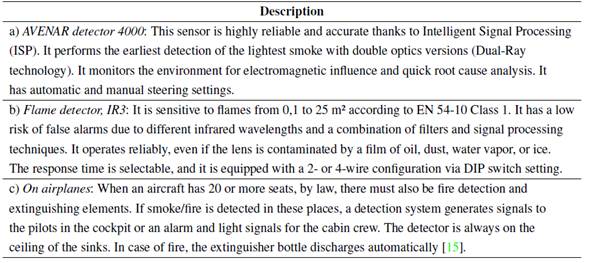
Gas accumulation sensors
Gases in air are as follows: Nitrogen, N2 (78,084 %); Oxygen, O2 (20,9476 %); Argon, A (0,934 %);Carbon dioxide, CO2 (0,0314 %); Neon, Ne (0,001818 %); Methane, CH4 (0,0002 %); Helium, He (0,000524 %); Krypton, Kr (0,000114 %); Hydrogen, H2 (0,00005 %); Xenon, Xe (0,0000087 %).The characteristics of gases indicate that they can be lighter, heavier, or have the same density as air. Gases may have an odor or be odorless, as well as colored or colorless. Some gases cannot be seen, smelled, or touched. There are four types of risks with gases as follows: flammable, toxic gas;asphyxiating, risk of fire and/or explosion. For example, methane, butane, and propane are associated with poisoning hazard; and carbon monoxide, hydrogen, and chlorine with choking hazard.Another risk is the lack of oxygen, which can be consumed or replaced by another gas. Choking hazard can result from a lack of oxygen. Humans need to breathe O2 in the air to live. Normal ambient air contains an oxygen concentration of 20,9% v/v. When the oxygen level falls below 19,5% v/v, the air is considered oxygen deficient. Oxygen concentrations below 16% v/v are not considered safe for humans. At a level of 16% a human suffers from exhaustion, but 6% is fatal.The details of this are shown in Table II.
Table II: Effect of carbon monoxide on humans 14

To detect the accumulation of gases in a closed environment, there are various types of sensors 14]. Some Honeywell sensors are shown in Table III.
Table III: Gas detector sensors

Temperature sensors
Thermometers are suitable for outdoor and indoor use. In this case, a car cabin is a closed area,for which there are several models. Table IV shows some of them.
Table IV: Temperature sensors

Today’s cars have a thermometer that reflects the temperature of the environment, but it does not accurately measure the temperature inside the car. However, there are industrial models that can send or store the temperature of a closed environment. The objective of a thermometer in the cabin is to measure the temperature and detect extreme temperatures (very low or very high) that may endanger the occupants.
State of the art
[8] addresses the problem of car fires. Most cars catch fire while refueling at a gas station. The problem is that, after the car fire, an explosion can occur. Other sources of fire can be high temperatures,friction, and the accumulation of gases. Therefore, there should be measures for the evacuation of the occupants to safety. Gas stations must have the means to handle a car fire emergency.In this case, a fire can occur while the car is stopped.
[16] focuses on the automation of fire prevention in cars. The authors seek to detect and extinguish the fire quickly and early while keeping the car and the occupants safe. Their proposal involves an automated extinguishing method, as well as smoke or flame sensors to emit an alarm and activate automated extinction. Finally, the flow of fuel and electricity could be stopped to minimize the risks.
A system can sound an alarm when a locked child is in danger. [17] Proposes to avoid heat shocks,hypothermia, and suffocation of children trapped in a closed and parked car. An average of 37 children dies each year in India from these causes. Another problem is the decrease in oxygen when it goes below 15 %, which makes it highly dangerous. The use of CO2 and temperature sensors is proposed to detect critical levels. Critical values are 550 parts per million of CO2 and 40 °C. Once critical levels are detected, a message is sent to the adult responsible for the vehicle. This work does not propose a solution if there is no response from the driver.
The temperature in the cabin of a car parked under the sun’s rays can reach heat or cold extremes.The temperature rises more than outside due to the greenhouse effect. The temperature under the sun can range from 41 to 76 °C, and it can drop to -19 °C. Therefore, trapped pets and children have died. Children become dehydrated faster than adults. The recommendations that were issued are: avoid parking the car under the sun’s rays and do not leave children locked inside [17].
Cold is also a problem in parked cars in certain parts of the world. The work by [19] focuses on showing a statistic of children who have suffered hypothermia between 1999 and 2007 in the United States. The authors found that 231 children aged one to 14 died of hypothermia in a car.More than 80% of cases were due to unattended children. 25% occurred while playing. 35% of cases involved children under one year old and 60% from 1 to 4 years old. 33% were in the care of the mother and 23% in the care of the father. Moreover, -21 °C for at least 15 minutes can be fatal.
An alert can be installed to warn of the risk of hypothermia, as presented in [20]. From 1998 to 2012, 530 children have died from hypothermia. Some of these deaths occurred in the South, followed by theWest, Midwest, and Northeast from United States. A temperature of 6,5 °C is fatal for a child in a car. A child is more affected than an adult by the cold due to body mass and composition.
The proposal is based on a temperature sensor and a motion sensor, as well as an Arduino board, to detect the presence of the child. Once a risk level is detected, an alert is sent to a caregiver application.The proposed solution is to open the window a little remotely. However, it is considered that the measure is not sufficient because it depends on the correct operation of the application.
Passive safety in the future must be improved and adapted to new conditions. In this case, [8]present a work in which they try to predict the possible risks that the occupants of a car could suffer and generate measures to mitigate the risks. Most crashes are head-on and cause damage to the thorax and spine of the occupants. Using a crash history, it is possible to predict a crash and the injuries that the occupants may sustain.
Methodology
Cabin dimensions
In this research work, we focus on cars with up to five passengers, which are mostly cars of the sedan and hatchback type. Both types of cars have similarities at the front and some differences at the rear. However, it is the same pattern for passengers: driver, co-pilot, and three occupants in the rear seats. Each passenger has space to sit and for their feet, as well as a distance from the head to the roof of the car.
For the sake of clarity, the places of the passengers have been numbered according to the place of precedence they occupy in the car. The places inside the car are numbered 1 through 5: place 1 is behind the driver, place 2 is behind the side opposite to the driver, place 3 is back in the middle,place 4 is opposite the driver, and the 5th place is occupied by the driver.
The size of the cabin is different according to the model and make of the car. However, the measurements show similar dimensions. Measurements from a Toyota Corolla were taken, which are shown in millimeters in Table V.
Table V: Interior space of a 2020 Toyota Corolla

Sensors
The on-board sensors can collect the presence of passengers from any of the five seats, and there are other sensors to register the temperature, toxic gases, and oxygen, as well as smoke and fire.They are shown in Table VI.
Table VI: Sensors considered for the proposed model

Sensor network
The sensor network is placed in the dash, on the roof, and on the left and right sides of the car.There is also a sensor in each seat. All sensors are active when the car is in motion or parked. All sensors are connected to the DXPS.
Sensor reading
The sensors gather census data and send them to the DXPS each second in different formats, so the inputs are normalized to 0s and 1s. For example, if the temperature is 19 °C, it becomes 0,whereas, if it is -1 °C, it becomes 1 because it represents a risk. In the same way, if the temperature is 41 °C, it becomes a 1.
The data are placed in a vector of 0s and 1s. If the pattern is 000000, it means that there is no risk.Therefore, if the pattern is 000010 there is some risk because there is at least one 1. Each position of the vector corresponds to a sensor and a risk (Table VII).
Table VII: Sensor keys as well as the risk they detect

A sensor is required in each seat since the objective is the protection of the occupants and the car. When at least one occupant is detected, the sensor network is activated, even when the car is stopped and turned off.
Device of extraordinary passive safety
The DXPS can receive signals and store the risk vector. It must also emit signals or alarms and activate actuators to mitigate the risk. This topic will be part of a future project.
An alternative is to use Internet of Things (IoT) devices: in this case, the connection between the car and the user’s cell phone. However, internet coverage is limited in many countries.
Experimental results
Sensor network
The sensor network must be installed in the car cabin with signal and power lines, which could involve a single harness placed during assembly (Fig. 1).
Figure 1: Car chassis [16]
The 2D sensor network map is presented. The sensors are installed during the assembly of the car. For the sake of convenience, the lines go on the floor of the car (Fig. 2).
Figure 2: 2D design of the sensor network
The sensors are connected to the DXPS. A sensor is intended for each of the seats because there is relevance when there is at least one passenger in the car. The sensor readings and hazard detection sequences are shown in Table VIII.
Table VIII: Sequence of readings sent to the DXPS

According to the readings of the sensors, the possible risks can be determined. Table IX shows the possible scenarios.
Table IX: Possible scenarios according to the detection of a risk

There are two sets of signals. The first corresponds to the risk sensors and the second to the seat sensors. Eq. (1) determines whether there is a risk, while Eq. (2) determines how many occupants there are in the car.


Where XR represents the number of risks, whereas OS refers to the occupants of the car. Therefore,it is necessary to apply an algorithm for risk assessment.
The algorithm required in the DXPS is shown below:
Algorithm 1: This algorithm is required to detect risks.
A state diagram shows the initial state of the sensors (in this case, 0s), as well as the events that generate a sensor state change. After the event, the status changes to value 1 (Fig. 3).
Figure 3: Initial status, events, and final status of the sensors
Discussion
The cost derived from the sensors and the DXPS, as well as their installation, aims to be implemented in mid-range and high-end cars. High-end cars have high-cost accessories and finishes.Therefore, the incorporation of more and better security measures should be considered.
Detecting a risk is not enough for security. It is necessary for the DXPS to send signals to actuators to mitigate the risk. Possible alternatives are: maintaining a temperature that does not endanger the lives of the occupants, having oxygen from the outside or from the inside, extracting toxic gases,and having emergency exits or mitigating the fire.
When a hazard is detected and there are no occupants, an alert must be activated. When opening the car, the occupants should avoid boarding. As a last resort, this consists of blocking the doors to prevent passengers from boarding.
The response of the sensors should occur in one second or less. When an alert is sent, passengers can get out of the car. The possible actuators must be opportune, so as not to risk the health of the occupants.
Conclusions
It is concluded that the proposed model allows the identification of extraordinary risks. The risks identified are extreme cold, extreme heat, suffocation, poisoning, and fire. This proposal seeks to protect the occupants especially when they are minors, asleep, drunk, unconscious, disabled, or very old. The model can be used to implement devices that avoid or mitigate risks. This solution can especially save children locked in the cabin.
Future research
The project has been planned in three stages. The first stage consists of the design of the sensor network, which is presented in this work. The second stage consists of creating a prototype of the network and obtaining the readings of the sensors. Finally, in the third stage, it is expected to implement the network in a car to carry out the pertinent tests. Through simulations, it will be possible to prove the efficiency of the DXPS.
References
License
Copyright (c) 2022 José Sergio Ruiz Castilla, Farid García Lamont

This work is licensed under a Creative Commons Attribution-NonCommercial-ShareAlike 4.0 International License.
From the edition of the V23N3 of year 2018 forward, the Creative Commons License "Attribution-Non-Commercial - No Derivative Works " is changed to the following:
Attribution - Non-Commercial - Share the same: this license allows others to distribute, remix, retouch, and create from your work in a non-commercial way, as long as they give you credit and license their new creations under the same conditions.

![Car chassis [16]](https://revistas.udistrital.edu.co/index.php/reving/article/download/18493/version/17281/17943/112417/0121-750X-inge-26-03-479-gf1.jpg)

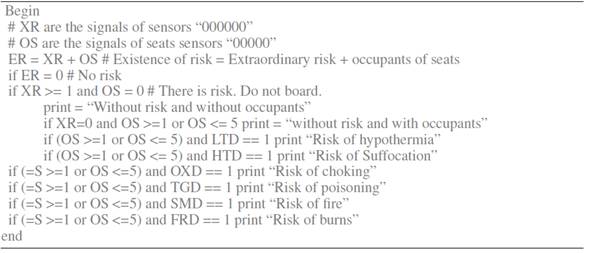
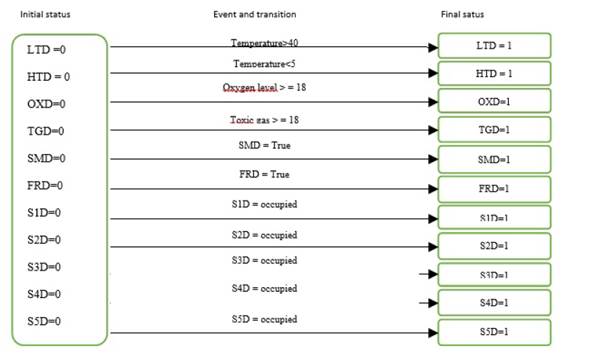



2.jpg)










